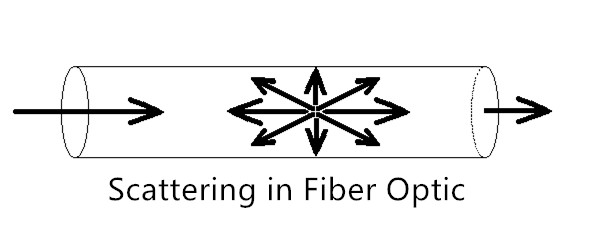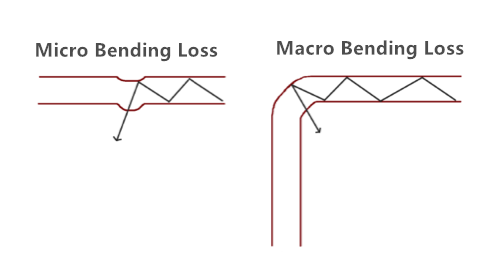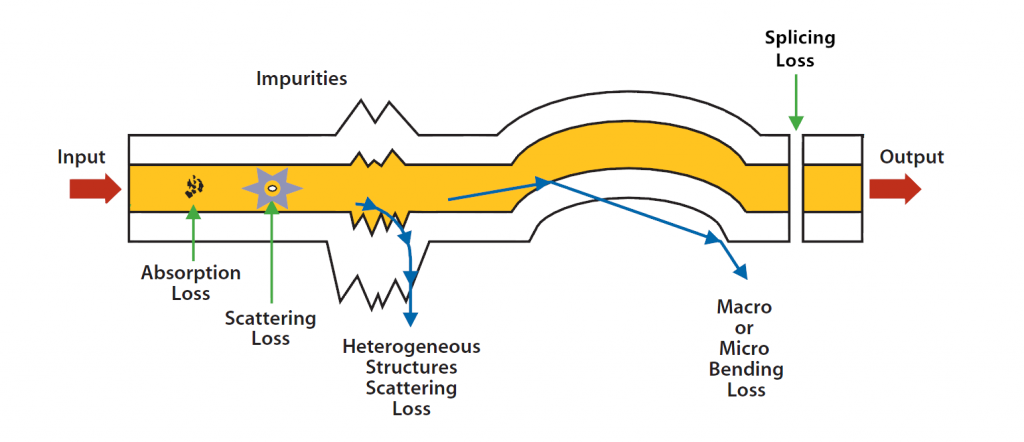Fiber optic transmission has become the backbone of networking in the majority of companies nowadays. Serving as the trend of data transmission in this information age, it does obtain some advantages when comparing with other transmission medium like copper. With lighter weight, smaller size and more flexibility, fiber optic enables data to transmit at a higher speed and over longer distances, which in turn helps to enhance the work efficiency greatly. However, there exist some elements that could affect the performance of fiber optic. So, in order to achieve stable and excellent performance of the fiber, we should take these factors into consideration. Among which fiber optic loss is easy to be neglected sometimes, but it is of significant importance for engineers when selecting and dealing with fiber optics. This article aims to provide some useful information about fiber optic loss in detail.
It is universally known that fiber optic cable transmits data as pulses of light go through tiny tubes of glass. During the process the light travels through the core of fiber optic, and the strength of it surely becomes lower. Naturally, the signal strength becomes weaker. This loss of light power is generally called fiber optic loss or attenuation. While in power lever, this decrease is described in dB. Something happened during the transmission of data and caused fiber optic loss. Therefore, to transmit optical signals smoothly and safely, it is essential to decrease fiber optic loss. So, firstly we should try to figure out where the loss comes from. The fiber optic loss falls into two aspects: internal reasons and external causes, which are also known as intrinsic fiber core attenuation and extrinsic fiber attenuation.
Internal reasons of fiber optic loss are caused by the fiber optic itself, which is also known as intrinsic attenuation. Basically, there are two main causes of intrinsic attenuation: light absorption and scattering.
Light absorption is the major cause of fiber optic loss during optical transmission, which means the light is absorbed in the fiber by the materials of fiber optic. Thus light absorption is also known as material absorption. Actually the light power is absorbed and transferred into other forms of energy like heat because of molecular resonance and wavelength impurities. Besides, atomic structure in any pure material may absorb selective wavelengths of radiation. Since it is impossible to manufacture materials that are totally pure, fiber optic cable manufacturers choose to doping germanium and other materials with pure silica to optimize the fiber optic core performance.
Scattering is another main cause of fiber optic loss. It refers to the scattering of light caused by molecular level irregularities in the glass structure. When the scattering happens, the light energy is scattered in all directions. Some of them keep traveling in the forward direction, but the light that doesn’t scatter in the forward direction could be lost in the fiber optic link as shown in the following picture. Thus, to reduce fiber optic loss caused by scattering, the imperfections of the fiber optic core should be removed, and the fiber optic coating and extrusion should be carefully controlled.

What we have mentioned above just serves as one aspect that causes fiber optic loss, the other one which is extrinsic fiber attenuation also plays an essential role in the loss of fiber optic. Extrinsic fiber attenuation is usually caused by improper handling of fiber optic. Thus, there are two main types of extrinsic fiber attenuation that may take place in fiber optic cable installation: bend loss and splicing loss.
Bend loss is a common problem generated by improper fiber optic handling that causes fiber optic loss. Literally, it is caused by fiber optic bend. There are two basic types of bend loss: one is micro bending, the other is macro bending (shown in the following picture). Macro bending refers to a large bend in the fiber (with more than 2mm radius). To reduce fiber optic loss, the following causes of bend loss should be noted:
- Fiber core deviate from the axis;
- Defects of manufacturing;
- Mechanical constraints during the fiber laying process;
- Environmental variations like the change of temperature, humidity or pressure.

Fiber optic splicing can also result in extrinsic fiber attenuation. As it is inevitable to connect one fiber optic to another in a fiber optic network, the fiber optic loss caused by splicing cannot be avoided. However, it can be reduced to minimum with proper handling. Using fiber optic connectors of high quality and fusion splicing can help to reduce the fiber optic loss effectively.

The picture above shows the main causes of loss in fiber optic cable of different types. Since efficient transmission of light at the operational wavelengths is the primary function of fiber optics needed for a range of applications, the fiber optic loss and the potential for its minimization are of great importance in the efficient and economic use of fiber optics. For the purpose of reducing the intrinsic fiber core attenuation, it is necessary to select the proper fiber optic and suitable optical components for the applications, while for reduction of extrinsic fiber attenuation, it would be better to handle the fiber optic properly and splice it with cautious.